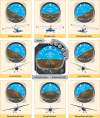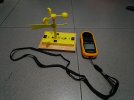I've never flown helicopters so I am a little confused about the attitude indicator of the Fly App.
The Fly App Attitude Indicator has fixed horizontal and vertical axes and a two tone sort of roll indicator. When the aircraft is flying forward, the line of the roll indicator is above the horizontal axis. The aircraft is pitched down so I would think that the fixed horizontal line represents the 'wings ' of the aircraft which are dipped below the horizon.
When the aircraft is flying backward, the line of the roll indicator is below the horizontal axis. The aircraft is pitched up so I would think that the fixed horizontal line represents the 'wings ' of the aircraft which are tilted above the horizon.
In both cases, I would think that the fixed horizontal line represents the wings. However, when the aircraft rolls to the right, the roll indicator is also rolled to the right when it should be rolled to the left.
Getting used to the DJI Fly App's AI might be a bad habit for me given that I fly fixed wing ACs.
But this is just me.
The Fly App Attitude Indicator has fixed horizontal and vertical axes and a two tone sort of roll indicator. When the aircraft is flying forward, the line of the roll indicator is above the horizontal axis. The aircraft is pitched down so I would think that the fixed horizontal line represents the 'wings ' of the aircraft which are dipped below the horizon.
When the aircraft is flying backward, the line of the roll indicator is below the horizontal axis. The aircraft is pitched up so I would think that the fixed horizontal line represents the 'wings ' of the aircraft which are tilted above the horizon.
In both cases, I would think that the fixed horizontal line represents the wings. However, when the aircraft rolls to the right, the roll indicator is also rolled to the right when it should be rolled to the left.
Getting used to the DJI Fly App's AI might be a bad habit for me given that I fly fixed wing ACs.
But this is just me.
Attachments
Last edited:













